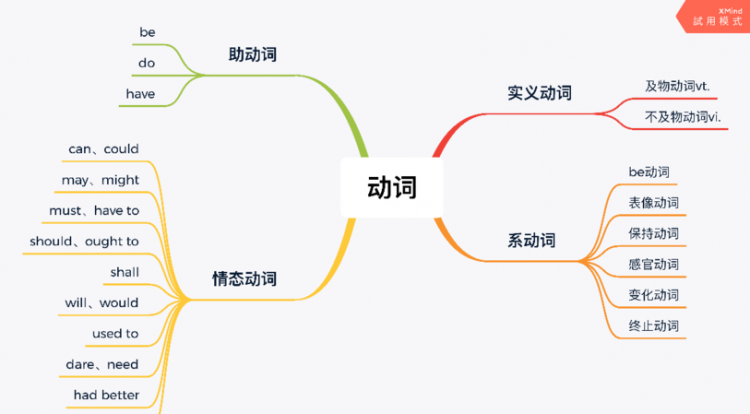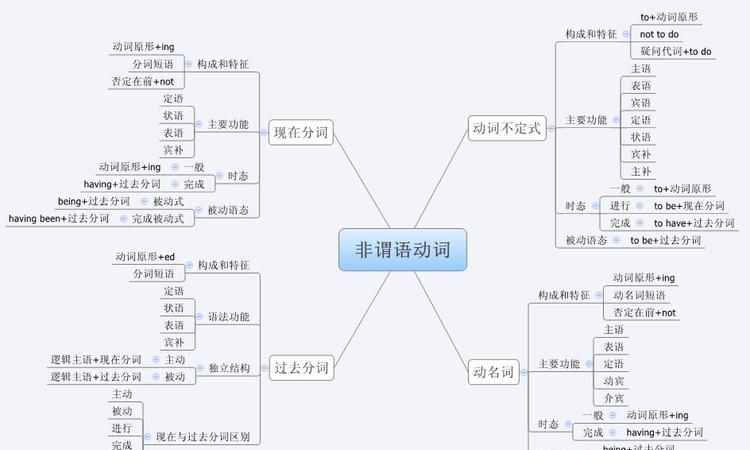本文目录
非谓语动词的用法总结
I. 非谓语动词做主语
1. 动词不定式=主语。
To serve the people is my duty.
2. 动名词=主语。
Looking after the children is her job.
3. 如果动词不定式/动名词很长,可以用 it 代替。
It is no use talking to him .
It is standard practice for a company like this one to employ a security officer .
II. 非谓语动词做宾语
1. 动词不定式=动词宾语
want、wish、hope、manage、demand、promise、refuse、pretend、plan、offer、decide、agree、expect。
He pretends to understand her words .
2. 动词不定式=介词宾语
but、except(除...之外)
She had nothing to do but stay at home . (有do省to)
He had no choice but to meet a greater challenge . (无do留to)
3. 动名词=动词宾语
admit、allow、appreciate、avoid、consider、delay、dislike、enjoy、escape、excuse、finish、forgive、imagine、keep、mind、miss、practice、resist、risk、suggest、deny、stand。
I suggested going to the exhibition next week .
4. 动名词=介词宾语
at、in、for、with、without、when it comes to、get down to。
My sister is good at playing the piano .
5. 动词不定式+动名词=动词宾语
(1)意义无差别
love、like、hate、prefer、intend、start、continue。
I intend to finish the task this morning .
I intend finishing the task this morning .
(2)意义有差别
forget、remember、mean、regret、try。
I remember turning off the lights when I went out of the lab. (灯已经关了)
I remember to turn off the lights when I leave the lab. (灯还没关)
III. 非谓语动词做宾语补足语。
1. 动词不定式 = 宾补
(1)带to的动词不定式
绝大多数动词。
The teacher didn't allow the students to go swimming in the lake .
(2)不带to的动词不定式
使役动词+感官动词:make、let、have 、see、hear、watch、observe、notice、feel、look at、listen to。
The director had her assistant pick up some hot dogs for the meeting.
2. 分词 = 宾补
(1)现在分词 = 正在进行。
I looked up and noticed a snake winding its way up the tree .
(2)过去分词 = 被动且已完成。
I heard a song sung in English .
IV. 非谓语动词做主语补足语
1. 动词不定式 = 主补
(1)一般动词
The visitors are requested to carry only one handbag .
(2)使役动词+感官动词
His little sister was made to cry by him.
2. 现在分词 = 主补
The man was seen climbing into the shop .
V. 非谓语动词做定语
1. 动词不定式做定语
(1)主动态
I have an article to write today .
(2)被动态
The decision to be made at the meeting will influence the future of our company.
2. 现在分词做定语
(1)主动态——正在进行
The man standing under the tree is his father.
(2)被动态——正在进行
The building being built will be a hospital.
3. 过去分词做定语——已经完成
After completing and signing it, please return the form to us in the envelope provided .
VI. 连词+非谓语动词
since、when、while、whenever、no matter how、once、until、if
1. 主动态
When walking on the street , he saw an old friend.
2. 被动态
When first introduced to the market , these products enjoyed great success.
VII. 独立主格结构

感官动词后面加do还是doing
感官动词有
sse/find/feel/watch/notice/hear sb do sth
感官动词为谓语,后面的do为动词不定式,作宾语补足语。

非谓语动词是什么
动词的非谓语形式有三种:不定式、动名词和分词。
不定式
不定式由“to+动词原形”构成,其否定形式是“not to do”。不定式可以带宾语或状语构成不定式短语。不定式没有人称和数的变化,有时态和语态的变化。不定式可以作主语、宾语、状语、表语和定语。不定式复合结构为“介词+sb.(sth.)+to do”,其中“介词+sb.(sth.)”表明不定式动作的发出者,为逻辑主语。
1. 不定式的用法:
(1)作主语。不定式短语作主语时,为了使句子结构平衡,常将不定式短语放在谓语之后,而用it作形式主语。
It is our duty to give as much help as possible. 提供尽可能多的帮助是我们的职责。
但不定式作表语时,前面有不定式作主语,不定式不可位于句末。
To see is to believe. 眼见为实。
(2)作宾语。常见的只跟不定式作宾语的动词(组)有want, wish, hope, expect, would like (love),care, choose, learn, plan, prepare, mean, agree, promise, offer, refuse, ask, beg, decide, make up one’s mind, be determined, manage, try, can’t afford, fail, pretend等。
①He promised to come today, but he hasn’t turned up yet .
他许诺说今天来,但他到现在还没有出现。
②No one likes to be laughed at. 没人喜欢被嘲笑。
有形容词、分词、名词作宾补,不定式作宾语时要将不定式放于句末,用it 来作形式宾语。如:
You may find it necessary to finish the work ahead of time.
你会发现有必要提前完成工作。
(3)作宾语补足语。常见的跟不定式作宾补的动词有ask, order, advise, like, want, teach, force, forbid, beg, allow, expect, cause, invite, tell, know, call on, depend on, wait for等。
The children asked their parents to take them to the park.。
孩子们要求父母带他们去公园。
感官动词后,如 see, watch, look at, observe, notice, hear, listen to, feel及部分表示“使”、“让”的使役动词,如have, make, let 跟不定式作宾补时要省略不定式符号to。但在被动语态中to 要加上。
Though he had often made his sister cry, today he was made to cry by his sister.
尽管他总是弄哭他妹妹,今天却被妹妹弄哭了。
help后的不定式作宾补(包括作宾语)to 可有可无。
(4)作表语。
My job is to help the patient. 我的工作是帮助病人。
要注意不定式作表语与“be to do”结构的不同:
不定式作表语说明主语的性质或内容,而“be to do”结构表示安排要做的事情。
①My next plan is to draw a picture for the house.(不定式作表语)
我下一个计划是为这座房子画一幅图。
②We are to meet at the school gate at six .(be to do表示安排)
我们约好六点在学校门口见面。
(5)作定语
①表示将来的动作。
The meeting to be held next week will be of great importance.。
下周将要举行的会议极为重要。
② 用在固定搭配中。
I will go to Shanghai tomorrow. Have you anything to be sent to your son?
我明天要去上海,你有什么东西要带给你儿子吗?
(send的动作发出者并非you,因此不定式用被动语态)
作定语的不定式如果与其前面所修饰的名词有逻辑上的动宾关系,然而动词又为不及物动词,动词后要加介词或副词,使其成为及物动词词组。
Will you find me a pen to write with? 你能给我找一支写字的笔吗?
不定式所修饰的词是time, place, way时,不定式后面的介词习惯上要省去。
Do you think it is the best way to deal with such a problem?
你认为这是解决问题的最好方式吗?
(6) 状语。表示目的、原因、结果。
①They ran over to welcome the guests. 他们跑过去欢迎客人。(目的)
②The child is too young to go to school. 孩子太小不能去上学。(结果)
③We were excited to hear the news. 听到这个消息我们激动了。(原因)
不定式的时态与语态
不定式有一般式、进行式、完成式形式,既有主动语态又有被动语态两种语态。形成to do, to be done, to be doing,to have done, to have been done形式。
(1)不定式的一般式所表示的动作通常与谓语的动作(状态)同时(或几乎同时) 发生,或是在它之后发生。
I’m sorry to tell you that you are wrong this time.
我很遗憾告诉你这次是你错了。
(2)如果谓语表示的动作(情况)发生时,不定式表示的动作正在进行, 这时不定式就要用进行式。
I am very glad to be talking with you. 我很高兴与你交谈。
(3)如果不定式的动作发生在谓语动词之前,就要用完成式。
I’m sorry to have kept you waiting for such a long time. 对不起,让你久等了。
当不定式逻辑上的主语是这个不定式所表示的动作的承受者时, 不定式要用被动语态。
He asked to be sent to work in the countryside. 他要求去农村工作。
动名词
动名词由“动词+ing”构成;具有动词和名词的性质,可以有宾语或状语; 可作主语、宾语、表语和定语。动名词有时态和语态的变化。
1. 动名词的作用
(1)作主语。
动名词短语作主语时,为了使句子平衡,常将动名词短语放在谓语之后,而用it作形式主语。
It is useless arguing with him about such a matter. 跟他争论这样的事情是没用的。
动名词和不定式都可作主语,在许多情况下可以通用,但动名词作主语多表示一般或抽象或多次的行为,不定式作主语往往表示具体的或一次性的动作。
在 It is no use/good, not any use/good, useless后人们习惯上用动名词。
(2)作宾语
下列动词(组)只能接动名词作宾语
admit, advise, allow, appreciate, avoid, consider, delay, enjoy, escape, excuse, finish, imagine, mind, pardon, permit, practise, suggest, require, be (get) used to(习惯于...), cant’t help(禁不住), feel like, set about, stick to, keep on, look forward to, devote oneself to, insist on, pay attention to, be worth, give up, put off。
下列动词后跟不定式或动名词意义区别不大:
begin, start, love, continue, hate, prefer。
下列动词后跟不定式或动名词意义不同,在平时学习中应特别注意。
forget, remember, regret, try, stop, mean, go on, can't help。
下列动词后跟动名词主动语态,不定式被动语态作宾语表示被动。
need, want, require。如:
These clothes need mending (to be mended).
(3) 作表语
动名词作表语多表示抽象性的或习惯性的动作,当表示下一步打算时多用不定式作表语。
①My job is teaching you English. 我的工作是教你英语。
②Her next step is to get as much money as she could to build the factory.
她下一步是获取尽可能多的资金建造工厂。
(4)作定语
动名词作定语表示用途,而不是正在进行着的动作。
He is now in the sleeping car. 他现在在房车里。
2. 动名词的复合结构
动名词的复合结构指在动名词前加物主代词或名词所有格。物主代词或名词所有格表明动名词动作的发出者。
His coming late made the teacher angry. 他的迟到让老师生气。
动名词的复合结构在句中作宾语时,物主代词或名词所有格可以变为人称代词的宾格或名词的普通格,但复合结构作主语时不变任何变化。
He entered the room without anyone noticing him.
他进入房间,没有人察觉到他。
Li Ming’s smoking ( 不可用Li Ming smoking) in the classroom surprised us.
李明在教室里吸烟让我们很吃惊。
3. 动名词的时态与语态
动名词的时态分为一般式和完成式两种形式。如果动名词的动作发生在谓语动词之前,则运用完成式;如果与谓语动词的动作同时发生或在其后发生,用一般式。
I’m sorry for not having kept my promise.
对不起,我没有遵守诺言。
若动名词与其逻辑主语有被动关系,则运用被动语态形式。( 但有些动词后运用主动形式表达被动概念,除上述动词外,be worth后也跟动名词主动形式表达被动概念)。
He entered the room without being noticed.
他进入房间而没被察觉。
分词
分词分为现在分词和过去分词。
1. 区别
(1)现在分词表示主动,过去分词表示被动。
①The man standing by the window is our teacher.
②The house built last year has become our lab.
(2)现在分词表示事物本身所具有的性质,意为“令人……的”; 过去分词表达由外界引起的内心活动,意为“感到……的”。
the exciting news 激动人心的消息。(令人兴奋的消息)
the excited look 激动的表情。
(3) 现在分词表达正在进行着的动作,过去分词表达完成的动作。(这一类动词主要为不及物动词)
①Electricity lines as well as telephone poles were brought down by falling trees or branches.
②The army was called in to cut through fallen trees and... .
2.分词的时态和语态
过去分词表示被动或完成的动作,因而没有完成式和被动语态。
现在分词有一般式和完成式两种形式, 有主动语态和被动语态两种语态,形成doing, having done, having been done的形式。
3. 分词的用法
(1)作定语
单个分词作定语一般放在所修饰词的前面,短语作定语放在所修饰词的后面。
①The question being discussed is important to us.
②The excited people rushed into the building.
(2)作状语
分词或分词短语作状语时,可以表示时间、原因、行为方式、结果、伴随状况等。
①Having been shown around the lab, we were led into a big hall. (时间)
②Being a student, I must study hard.(原因)
③They worked day and night, finishing the work ahead of time.(结果)
不定式也可以作结果状语,然而不定式多表达意料之外的结果,而现在分词表达意料之中的结果。
①She went to Shanghai specially to see her brother, only to find that he had gone to Beijing a few days before.
她专程去上海看望她的兄弟,却发现他几天前去了北京。
②They got up very early that day, finding nobody in the station when they got there.
那天他们很早就起床了,到了车站却发现那里空无一人。
(3)作表语
①The news is inspiring. 这消息令人鼓舞。
②The window is broken. 窗户破了。
(4)作宾补
①We had the fire burning all day. 我们让这火整天烧着。
②I’m afraid I can't make myself understood when I speak English.
我担心当我说英语是别人听不懂。
不定式被动语态、现在分词被动语态、过去分词表示被动应该注意的几个问题。
1. 不定式的被动语态作状语时多表达目的,相当于in order to be done, 而过去分词则表示原因、条件、伴随等;现在分词被动语态的完成式强调分词的动作发生在谓语动词动作之前。
①In the circus, the tamed animals will be given some food when they finish tricks. To be given more food, the animals will try their best to please the trainer.
在马戏团里,当驯兽完成它们的把戏,会得到一些食物。若要得到更多食物,它们就要尽其所能来取悦驯兽师。
(To be given...=In order to be given...,表示目的,此处不可用Given 或 Being given)
②Having been asked some very difficult questions, the boy came into the office.
男孩被问了一些很难的问题后,来到办公室里。
(Having been asked...=After he was asked..., 表示ask 的动作发生在come 之前)
2. 不定式的被动语态作定语表达将来的动作, 过去分词作定语表达过去或完成的动作,现在分词被动语态的一般式表达一种正在进行的动作。
①The meeting to be held next week is about how we can deal with this problem.
下周要开的会是关于我们如何解决这个问题的。
(to be held=which is to be held, be to 在此表达将来)
②The book published last month sells well. 上月出版的那本书卖得很好。
( published = which was published, published不可用to be published或being published代替)
③The building being built now will be finished in ten days. 正在建筑的那栋楼,10天内完工。
(being built=which is being built, 表示正在进行的动作)
3. 作宾补时,若非谓语动词与其前面的宾语有逻辑上的被动关系, 表示感官的动词,如 see, find, watch, notice, hear, feel 及部分使役动词,如:have, keep, get, let 等后跟过去分词作宾补;allow, advise,forbid, permit, want, order 等后跟不定式被动语态作宾补。
①The Emperor ordered the cloth to be woven for him right away.
皇帝命令说立刻为他织那块布。
②When she got home, she found her windows broken.
当她回到家时,发现窗户破了。

非谓语动词的使用条件
非谓语动词
★分词、不定式作宾补用法要点
一、分词、不定式作宾语补足语的区别
1.感官动词see, watch, observe, look at, hear, listen to, notice 等和使役动词have 后面的宾补有三种形式,即原形动词(不带to 的不定式)、现在分词和过去分词。现在分词表主动或正在进行,过去分词表被动或完成,动词原形表主动和完成。如:
I heard her sing an English song just now.
刚才我听见她唱了一首英文歌。
I heard her singing an English song when I passed by her room yesterday.
昨天经过她房间时,我听见她在唱英文歌。
I heard the English song sung many times.
我多次听到有人唱这首英文歌。
注意:不及物动词的过去分词作宾补表完成和状态。如:
I looked down at my neck and found my necklace gone. (状态)
I was surprised to find my hometown changed so much. (完成)
2.leave 后接三种形式作宾补时,其中的leave 保留了原来之义“留下”,但表达的确切之义应是“使……处于某种状态)。
leave sb. doing sth. 让某人一直做某事(宾语和宾补之间是主谓关系,表示动作正在进行。)
leave sth. undone 留下某事未做(宾语和宾补之间是动宾关系,表示被动和完成,一般以undone, unfinished, unsettled, untouched 为多)
leave sb. to do sth. 留下某人做某事
leave sth. to be done 留下某事要做(不定式表示将来的动作。)
如:It’s wrong of you to leave the machine running.
你让机器一直开着是不对的。(主动,正在进行)
The guests left most of the dishes untouched, because they didn’t taste delicious.
客人们没有动大部分菜,因为它们尝起来不可口。(被动,完成)
He left, leaving me to do all the rest work.
他走了,留下我一人去做剩余的工所有工作。(主动,将来)
We hurriedly ended our meeting, leaving many problems to be settled.
我们匆匆忙忙地结束了会议,留下了很多问题等待解决。(被动,将来)
3.have, get 后接三种形式作宾补时,其中have, get 表示“使、让、叫”之意。
① have sth. dOne= get sth. done “使/让某事由别人去做”(叫/让某人做某事)。如
I’ll have /get my bike repaired tomorrow.
此外,have sth. done 还表示“使遭受……”之意。如
Tom had his leg broken while playing football.
Mr. Smith had his house broken into while he was away on holiday.
② have sb. / sth. doing 使/让某人/物持续地做某事(现在分词表示主动,正在进行)
get sb. / sth. doing 使某人/物开始行动起来
如:The peasants had the tractor working day and night at the harvest time.
农忙时,农民们让拖拉机夜以继日地干活。
The captain got the soldiers moving toward the front after a short rest.
休息了片刻之后,上尉让士兵们开始朝前线行进起来。
注意:“have sb. doing”若用于否定句中,其中have 有“容忍”之意。如:
I won’t have you speaking to your parents like that.
我不会让你那样子跟你的父母说话。
Don’t have the water running all the time. 不要让水流个不停。
③ have sb. do sth. (get sb. to do sth. ) 使/让/叫某人去做某事
如:Mother had me go to the shop and buy some salt.
I can’t get him to stop smoking. He won’t listen to me.
二、下列动词后跟带to 的不定式作补语:
advise, allow, ask, beg, cause, encourage, expect, forbid, force, get, intend, invite, like, love, order, persuade, prefer, require, teach, tell, want, warn, wish, 等。如:
① An army spokesman stressed that all the soldiers had been ordered to issue clear warning before firing any shots.
② The teacher asked us not to make so much noise.
③ The flu is believed to be caused by viruses that like to reproduce in the cells inside the human nose and throat.
三、不定式、现在分词作宾补小窍门
下列动词后在主动语态中用不带to 的不定式作补语,但在被动语态中要加上to:
它们是“吾看三室两厅一感觉”——5看(look at, see, watch, notice, observe);3使(make, let, have);2听(listen to, hear);1感觉(fell)。以上动词还可用现在分词作宾语补足语(5+3+2+1-2+4):即以上动词除let, make 外都可以用现在分词作宾语补足语,此外find, catch, keep, have 也可以用现在分词作宾语补足语。
如:At that time, I found him crying in the street.
He was caught stealing. I’m sorry to have kept you waiting for such a long time.
The missing boys were last seen playing near the river.
★不定式、分词作定语用法要点
一、不定式作定语
1.作定语的不定式如果是不及物动词,或者不定式所修饰的名词或代词是不定式动作的地点、工具等,不定式后面须有相应的介词。如:
The Browns have a comfortable house to live in.
There is nothing to worry about.
Please give me a knife to cut with.
Here is some paper for you to write on.
但是,不定式所修饰的名词如果是time, place 或way时,不定式后面的介词习惯上省去。如:He had no money and no place to live (in).
We found a way to solve this problem (in).
2.当作定语的不定式所修饰的名词或代词是不定式动作的承受者时,不定式既可以用主动语态,也可用被动语态,但其含义有所不同。试比较:
Have you anything to send ? 你有什么东西要寄吗?(不定式to send 的动作执行者是“你”)
Have you anything to be sent ? 你有什么要(我或别人)寄的东西吗?
(不定式to be sent 的动作执行者是“我”或“别人”)
3.用不定式作定语的几种情况:
不定式表将来:
I borrowed some books to read during my holiday.
用来修饰被序数词、最高级或no, all, any 等限定的中心词。如:
He was the best man to do the job.
She was the first woman to win the gold medal in the Olympic Games.
Women and children were the first to get into the lifeboats.
用来修饰的词是抽象名词时,常见的有:ability, chance, idea, fact, excuse, promise, answer, reply, attempt, belief, way, reason, moment, time 等。如:
Do you have the ability to read and write English ?
I have a chance to go sight –seeing.
二、分词作定语
1.作定语的及物动词分词形式为:V –ing; being + 过去分词;当被修饰的名词与分词为主动关系时,用V –ing;当被修饰的名词与分词为被动关系且表正在进行时,用being + 过去分词;当被修饰的名词与分词为被动关系且表完成时,用过去分词。例如:
The houses being built are for the teachers.
The broken glass is Tom’s.
I have never seen a more moving movie.
2.作定语的不及物动词分词形式为:V –ing 和过去分词。V –ing 表示正在进行;过去分词表示已经完成。如:
falling leaves 正落的叶子 fallen leaves 落下的叶子
boiling water 正沸腾的水 boiled water 沸腾过的水(白开水)
三、不定式、过去分词和现在分词被动式作定语的区别
这三种形式作定语,主要是体现在动作的发生时间上。过去分词表示的动作或是在谓语所表示的动作之前发生,或是没有一定的时间性。如:
Have you read the novel written by Dickens ?
He is a man loved and respected by all.
Don’t use words, expression_r_rs, or phrases known only to people with specific knowledge.
现在分词的被动式作定语时表示的动作正在发生或是与谓语动词所表示的动作同时发生。如:Listen ! The song being sung is very popular with the students.
不定式的被动式作定语时,表示一个未来的动作。
如:The question to be discussed at the tomorrow’s meeting is a very important one.
★不定式、动名词作宾语用法要点
一、下面动词只能用不定式作宾语,请牢记下列小诗:
决心学会想希望,拒绝设法愿假装。
主动答应选计划,同意请求帮一帮。
Decide / determine, learn, want, expect / hope / wish, refuse, manage, care, pretend, offer, promise, choose, plan, agree, ask / beg, help
此外,afford, strive(斗争) 等也要用不定式作宾语。例如:
① She pretended not to see me when I passed by.
② We agreed to meet here but so far she hasn’t turned up yet.
③ In order to gain a bigger share in the international market, many state-run companies are striving to make their products more competitive.
二、下列动词只能用动名词作宾语,请牢记下列小诗:
考虑建议盼原谅,承认推迟没得想。避免错过继续练,否认完成停欣赏,不禁介意准逃亡。
consider / suggest / advise, look forward to, excuse, pardon, admit, delay/ put off, fancy, avoid, miss, keep / keep on, practise, deny, finish, enjoy / appreciate, can’t help, mind, allow / permit, escape, imagine, forbid, risk
此外be used to, look forward to, lead to, devote to, stick to, object to, get down to, pay attention to, can’t stand (无法忍受), give up, feel like, insist on, put off, thank you for, apologize for, be busy (in), have difficulty / trouble (in), have a good / wonderful /hard time (in)等动词词组也要用动名词作宾语。
① The squirrels was lucky that they just missed being caught.
② I can hardly imagine Peter sailing across the Atlantic Ocean in five days.
③ I would appreciate your calling back this afternoon.
三、下列动词或词组既可以跟动名词作宾语,也可以跟不定式作宾语,但意义上有区别,要特别注意。
1. forget to do sth. 忘记去做某事 forget doing sth. 忘记已经做过某事
remember to do sth. 记住去做某事 remember doing sth. 记得曾经做过某事
regret to do sth. 后悔/遗憾去做某事 regret doing sth. 后悔做过某事
stop to do sth. 停下来去做另一件事 stop doing sth. 停止做一件事情
try to do sth. 努力/试图做某事 try doing sth. 尝试着做某事
mean to do sth. 意欲/想/企图做某事 mean doing sth. 意味着做某事
go on to do sth. (做完某事)接着做另一件事 go on doing sth.继续做同一件事(=go on with sth.)
can’t help to do sth. 不能帮助做某事 can’t help doing sth. 情不自禁地做某事
2.动词like, love, prefer 后接不定式或动名词作宾语均可。如表示经常性的行为可用动名词,如表示具体的行为常用动词不定式。但要注意:如果like, love, prefer 前有would /should 后面则应接动词不定式。如:
I like swimming, but I don’t like to swim this afternoon.
I’d like to go swimming this weekend.
3.在动词allow, advise, forbid, permit 后直接跟动名词形式作宾语,如果后面有名词或代词作宾语,其后用动词不定式作宾语补足语。即:
allow / advise /forbid / permit doing sth.
allow / advise /forbid / permit sb. to do sth.
如:We don’t allow smoking here.
We don’t allow students to smoke.
4.动词need, require, want 作“需要”解时,其后必须用动名词的主动形式或不定式的被动形式作宾语,表示事情需要做。这时动名词的主动式表示被动意义。be worth 后必须用动名词的主动形式表示被动意义。此外,若动词need 表“需要”,require 表“要求”,want 表“想要”这些意义时,其后须接名词或代词作宾语,然后接不定式作宾语补足语。即:
need / require / want doing / to be done
need / require / want sb. to do sth.
be worth + n. (表示钱数或相当于钱数的名词)
be worth doing be worthy of being done
be worthy of + n. 值得…… be worthy to be done
如:The window needs / requires / wants cleaning.
The window needs / requires / wants to be cleaned.
窗户需要擦一下。
The place is worth visiting.
The place is worthy of a visit.
The place is worthy of being visited.
The place is worthy to be visited.
那个地方值得一去。
如:① only one of these books is worth reading.
② — What do you think of the book ?
— Oh, excellent, It’s worth reading a second time.

以上就是关于非谓语感官动词,非谓语动词的用法总结的全部内容,以及非谓语感官动词 的相关内容,希望能够帮到您。
